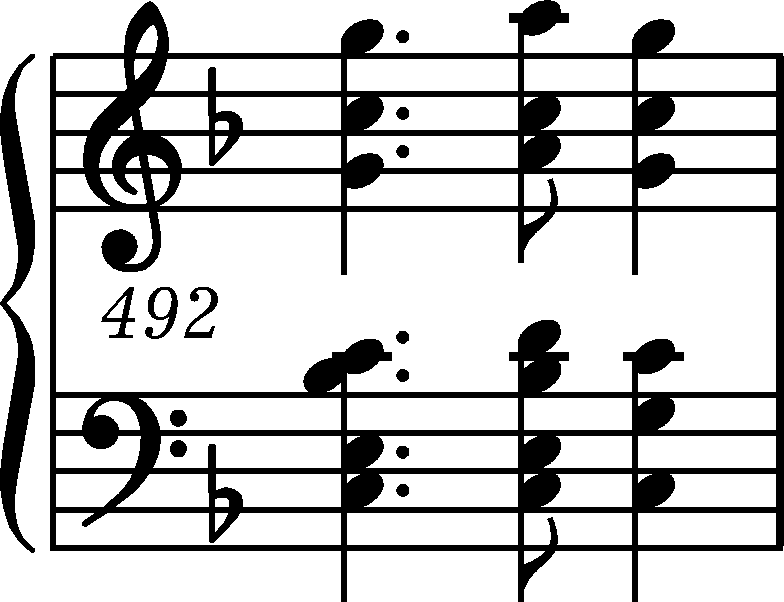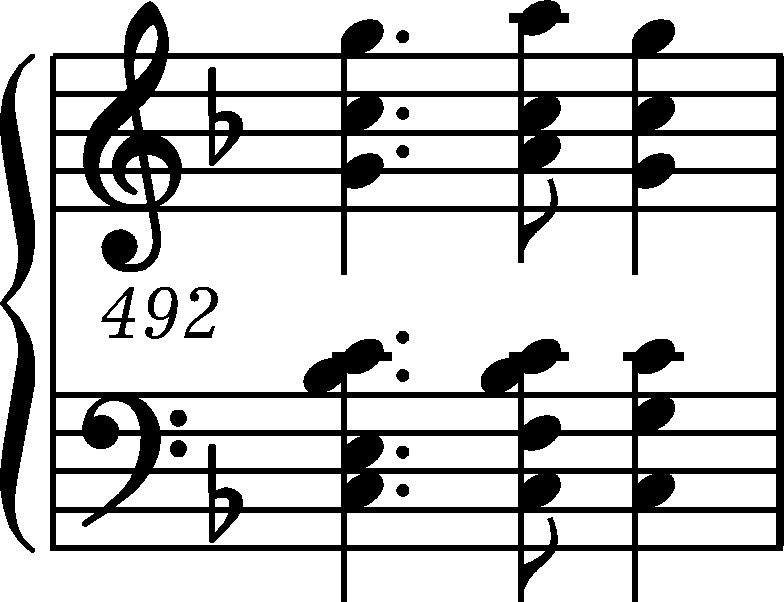



The sound of the last two chords in this bar is questionable in all sources. Both were most probably written erroneously already in A:  . In the quaver chord it is the topmost note (d1) that is erroneous, creating parallel fifths with the melodic voice and absent in all other versions. The mistake must have been committed by the person boldening the original delicate notation of Chopin (see the characterization of A), perhaps inaccurate. The last chord also seems to be erroneous; its empty sound does not result from voice leading and it clearly differs from the previous chords in the character, since the previous chords clearly show this dominant, final in the entire Concerto. The exceptionally big and diagonal note head of c1 indicates a possible root of the mistake – Chopin may have written two notes there, b
. In the quaver chord it is the topmost note (d1) that is erroneous, creating parallel fifths with the melodic voice and absent in all other versions. The mistake must have been committed by the person boldening the original delicate notation of Chopin (see the characterization of A), perhaps inaccurate. The last chord also seems to be erroneous; its empty sound does not result from voice leading and it clearly differs from the previous chords in the character, since the previous chords clearly show this dominant, final in the entire Concerto. The exceptionally big and diagonal note head of c1 indicates a possible root of the mistake – Chopin may have written two notes there, b -c1, which merged into one note after having been written in bold:
-c1, which merged into one note after having been written in bold:  . This reconstruction is confirmed by the notation of [ReF] (see below), in which the last chord is written in such a form.
. This reconstruction is confirmed by the notation of [ReF] (see below), in which the last chord is written in such a form.
However, even the reconstructed text of the Chopinesque reduction is not compliant with any of the sources of the orchestral part. [ReF] features a tonic chord in the second inversion as the 2nd chord:  . This version could be considered the original concept of this bar, which is indicated by the symmetrical progression of the middle voices in the L.H. –
. This version could be considered the original concept of this bar, which is indicated by the symmetrical progression of the middle voices in the L.H. –  . Since the 2nd chord in the bar is a dominant chord in all the remaining versions, Chopin had to resign from this version, most probably in order not to debilitate the effect of the concluding, suspended dominant.
. Since the 2nd chord in the bar is a dominant chord in all the remaining versions, Chopin had to resign from this version, most probably in order not to debilitate the effect of the concluding, suspended dominant.
In Morch, the dominant character of the 2nd chord is noticeable, yet it is neutralised by the missing seventh:  . In turn, it is worth emphasising the return of the 3rd chord to the sound of the first one. While comparing this version with the reconstructed text of A, one may have an impression that Chopin did not manage to fully coordinate the corrections introduced in both parts of ½A. In the new, dominant harmonic context, it is the 2nd chord in the version of A and the third one in the version of Morch that are to be considered better, as far as the sound is concerned.
. In turn, it is worth emphasising the return of the 3rd chord to the sound of the first one. While comparing this version with the reconstructed text of A, one may have an impression that Chopin did not manage to fully coordinate the corrections introduced in both parts of ½A. In the new, dominant harmonic context, it is the 2nd chord in the version of A and the third one in the version of Morch that are to be considered better, as far as the sound is concerned.
GE (→FE1→EE) reproduced the version of A, correcting the mistake in the 2nd chord in the bar, but not in the third one:  . The change could have been performed by Chopin, although the fact of leaving the 3rd chord in this almost certainly erroneous form is naturally puzzling.
. The change could have been performed by Chopin, although the fact of leaving the 3rd chord in this almost certainly erroneous form is naturally puzzling.
The next stage of developing the sound of this bar is the change of the 2nd chord, performed in the last phase of proofreading of FE2 (it was not taken in EE):  . This time the last chord also remained unchanged, although the change of the 2nd chord must have been introduced upon inspiration from Chopin. The chord in this version constitutes an artful combination of the original concept of the tonic chord with the later one, based on the dominant. After taking into account the possible reconstruction of the repeated last chord of A, the version would look like that:
. This time the last chord also remained unchanged, although the change of the 2nd chord must have been introduced upon inspiration from Chopin. The chord in this version constitutes an artful combination of the original concept of the tonic chord with the later one, based on the dominant. After taking into account the possible reconstruction of the repeated last chord of A, the version would look like that:  , which certainly improves the version of A. In accordance with what was said about a possible lack of coordination of the corrections introduced in Morch and A (→GE1→FE1), it seems to be possible to combine the corrected version of the 2nd chord in FE2 with the fuller sounding version of the 3rd chord resulting from the notation of Morch:
, which certainly improves the version of A. In accordance with what was said about a possible lack of coordination of the corrections introduced in Morch and A (→GE1→FE1), it seems to be possible to combine the corrected version of the 2nd chord in FE2 with the fuller sounding version of the 3rd chord resulting from the notation of Morch:  . According to us, the version could correspond to Chopin's final intention. He used such a harmony – in a similar rhythm – in the Impromptu in F
. According to us, the version could correspond to Chopin's final intention. He used such a harmony – in a similar rhythm – in the Impromptu in F major, op. 36, bars 31, 35 and analog.
major, op. 36, bars 31, 35 and analog.
Compare the passage in the sources »
category imprint: Graphic ambiguousness; Interpretations within context; Differences between sources; Editorial revisions; Corrections & alterations
issues: Foreign hand additions in manuscripts, Errors of A, Accompaniment changes, Authentic corrections of FE, Authentic corrections of GE
notation: Pitch





